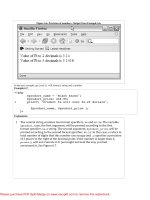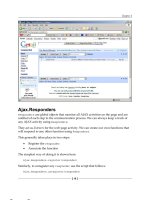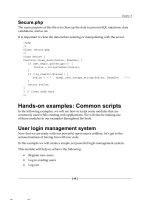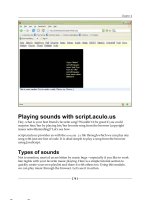Tài liệu PHP and MySQL by Example- P3 ppt
Bạn đang xem bản rút gọn của tài liệu. Xem và tải ngay bản đầy đủ của tài liệu tại đây (1.43 MB, 50 trang )
constant!to!the!following!script!that!will!define!a!
COPY_RIGHT
!constant!containing!
your!
SITE_NAME
!with!the!copyright!symbol!appended!(concatenated)!to!it.!Display!
the!constants!and!their!corresponding!values!in!an!HTML!table.!Hint:!See!
/><?php> // Define your site name, since it does NOT change // anywhere
within your script. define( 'SITE_NAME', 'Your site' ); // Define the
current year, possibly to use in your copyright // statement or for
'date' calculations. define( 'THIS_YEAR', date('Y') ); ?>
!
Please purchase PDF Split-Merge on www.verypdf.com to remove this watermark.
Chapter 5. Operators
“Operator, give me the number for 911.”
—Dan Castellaneta
5.1. About PHP Operators and Expressions
Data objects can be manipulated in a number of ways by the large number of operators provided by PHP. Operators are
symbols, such as +, -, =, >, and <, that produce a result based on some rules. An operator manipulates data objects
called operands; for example, 5 and 4 are operands in the expression 5 + 4. Operators and operands are found in
expressions. An expression combines a group of values to make a new value, n = 5 + 4. When you terminate an
expression with a semicolon, you have a complete statement; for example, n = 5 + 4;
!"#$%&&'()*
sum
*
=
*
5
*
+
*
4
*
)%+*,-./%* (#%$-0($* (#%$-)1* (#%$-0($* (#%$-)1*
*
In the numeric expression 5 + 4 - 2, three numbers are combined. The operators are the + and - signs. The
operands for the + sign are 5 and 4. After that part of the expression is evaluated to 9, the expression becomes 9 - 2.
After evaluating the complete expression, the result is 7. Because the plus and minus operators each manipulate two
operands, they are called a binary operators. If there is only one operand, the operator is called a unary operator, and if
there are three operands, it is called a ternary operator. We’ll see examples of these operators later in the chapter.
The operands can be either strings, numbers, booleans, or a combination of these. Some of the operators we have
already used are the concatenation operator to join two strings together, the reference operator to create an alias for a
variable, and the assignment operator to assign a value to a variable. Now let’s look at a whole plethora of additional
PHP operators and see how they manipulate their operands.
5.1.1. Assignment
An assignment statement evaluates the expression on the right side of the equal sign and assigns the result to the
variable on the left side of the equal sign. The equal sign is the assignment operator.
$total = 5 + 4; $name = "Tony";
*
5.1.2. Precedence and Associativity
When an expression contains a number of operators and operands, such as 5 * 4 + 3 / -2.2, and the order of
evaluation is ambiguous, then PHP must determine what to do. This is where the precedence and associative rules come
Please purchase PDF Split-Merge on www.verypdf.com to remove this watermark.
in. They tell PHP how to evaluate such an expression. Precedence refers to the way in which the operator binds to its
operand; that is, should addition be done before division or should assignment come before multiplication. The
precedence of one operator over another determines what operation is done first. As shown in the precedence table (see
Table 5.1), the operators are organized as a hierarchy, with the operators of highest precedence at the top, similar to a
social system where those with the most power (or money) are at the top. In the rules of precedence, the multiplication
operator is of higher precedence than the addition operator, technically meaning the operator of higher precedence binds
more tightly to its operands. The assignment operators are low in precedence and thus bind loosely to their operand. In
the expression sum = 5 + 4, the equal sign is of low precedence so the expression 5 + 4 is evaluated first and then
the result is assigned to sum. Parentheses are of the highest precedence. An expression placed within parentheses is
evaluated first; for example, in the expression 2 * ( 10 - 4 ), the expression within the parentheses is evaluated
first and that result is multiplied by 2. When parentheses are nested, the expression contained within the innermost set
of parentheses is evaluated first.
Table 5.1. Precedence and Associativity (Highest to Lowest)
Operator( Description( Associativity(
()
*
2-$%)03%&%&* 4%50*0(*$'630
7-8
*
new
*
9$%-0%&*-)*(:;%<0* =()-&&(<'-0',%*
[
*
>$$-?*&/:&<$'#0* @'630*0(*.%50*
++ --
*
>/0(*')<$%A%)0B*1%<$%A%)0* =()-&&(<'-0',%*
! ~ -
*
4(6'<-.*)(0B*:'0+'&%*)(0B*)%6-0'()* =()-&&(<'-0',%*
(int) (float)
*
(string) (array)
(object)
*
9-&0* **
@
*
C)3':'0*%$$($&* **
* / %
*
D/.0'#.?B*1','1%B*A(1/./&* 4%50*0(*$'630*
+ - .
*
>11B*&/:0$-<0B*&0$')6*<()<-0%)-0'()* 4%50*0(*$'630*
<< >>
*
E'0+'&%*.%50*&3'50B*$'630*&3'50* 4%50*0(*$'630*
< <=
*
4%&&*03-)B*.%&&*03-)*($*%F/-.*0(* 4%50*0(*$'630*
> >=
*
G$%-0%$*03-)B*6$%-0%$*03-)*($*%F/-.*
0(*
**
= = !=
*
!F/-.*0(B*)(0*%F/-.*0(* =()-&&(<'-0',%*
= = = != =
*
C1%)0'<-.*0(*H&-A%*0?#%IB*)(0*
'1%)0'<-.*0(*
**
&
*
E'0+'&%*>=J* 4%50*0(*$'630*
^
*
E'0+'&%*KL@* **
|
*
E'0+'&%*L@* **
Please purchase PDF Split-Merge on www.verypdf.com to remove this watermark.
Table 5.1. Precedence and Associativity (Highest to Lowest)
Operator( Description( Associativity(
&&
*
4(6'<-.*-)1* 4%50*0(*$'630*
||
*
4(6'<-.*($* 4%50*0(*$'630*
? :
*
M%$)-$?B*<()1'0'()-.* 4%50*0(*$'630*
= += -= *= /= %= <<= >>=
*
>&&'6)A%)0* @'630*0(*.%50*
and
*
4(6'<-.*>=J* 4%50*0(*$'630*
xor
*
4(6'<-.*KL@* 4%50*0(*$'630*
or
*
4(6'<-.*L@* 4%50*0(*$'630*
B*H<(AA-I* 4'&0*&%#-$-0($B*%0<N* 4%50*0(*$'630*
*
[a]
Not listed in the PHP manual, but seems to behave the same as in other languages.
Associativity refers to the order in which an operator evaluates its operands: left to right, in no specified order, or right
to left. When all of the operators in an expression are of equal precedence (see Table 5.1), normally the association is
left to right; for example, in the expression 5 + 4 + 3, the evaluation is from left to right. In the following statement,
how is the expression evaluated? Is addition, multiplication, or division done first? In what order, right to left or left to
right?
Example 5.1.
<html>
<head><title>Precedence and Associativity()</title>
</head>
<body bgcolor="lightgreen">
<font face = "arial" size = '+1'>
<?php
1 $result = 5 + 4 * 12 / 4;
print "$result = 5 + 4 * 12 / 4";
2 $result = (5 + 4) * 12 / (4 - 2);
print "<br />$result = ( 5 + 4 ) * 12 / (4 - 2) ";
?>
</body>
Please purchase PDF Split-Merge on www.verypdf.com to remove this watermark.
Explanation
O* M3%*($1%$*(5*-&&(<'-0','0?*'&*5$(A*.%50*0(*$'630N*D/.0'#.'<-0'()*-)1*1','&'()*-$%*(5*-*3'63%$*
#$%<%1%)<%*03-)*-11'0'()*-)1*&/:0$-<0'()B*-)1*-11'0'()*-)1*&/:0$-<0'()*-$%*(5*-*3'63%$*
#$%<%1%)<%*03-)*-&&'6)A%)0N*M(*'../&0$-0%*03'&B*+%P..*/&%*#-$%)03%&%&*0(*6$(/#*03%*
(#%$-)1&*-&*03%?*-$%*6$(/#%1*:?*2Q2N*C)*5-<0B*'5*?(/*+-)0*0(*5($<%*#$%<%1%)<%B*/&%*03%*
#-$%)03%&%&*-$(/)1*03%*%"#$%&&'()*0(*6$(/#*03%*(#%$-)1&*')*03%*+-?*?(/*+-)0*03%A*
%,-./-0%1N*M3%*5(..(+')6*0+(*%"-A#.%&*#$(1/<%*03%*&-A%*$%&/.0N**
var result = 5 + 4 * 12 / 4;
*
<(/.1*:%*+$'00%)**
result = (5 + ( ( 4 * 12 ) / 4));
*
R* C)*03'&*%"-A#.%B*03%*%"#$%&&'()&*%)<.(&%1*+'03')*#-$%)03%&%&*-$%*%,-./-0%1*5'$&0N*M3%*
*
*
-)1*
/
*-$%*%,-./-0%1*.%50*0(*$'630*:%<-/&%*03%?*-$%*(5*03%*&-A%*#$%<%1%)<%N*L/0#/0*(5*03'&*
%"-A#.%*'&*&3(+)*')*S'6/$%*TNON*
*
Figure 5.1. Output from Example 5.1.
*
Table 5.1 summarizes the rules of precedence and associativity for the PHP operators. The operators on the same line
are of equal precedence. The rows are in order of highest to lowest precedence.
Example 5.2.
<html>
<head><title>Precedence and Associativity()</title>
</head>
<body bgcolor="lightgreen">
<font face = "arial" size = '+1'>
<?php
1 $result = 5 + 4 * 12 / 4;
2 print "$result = 5 + 4 * 12 / 4";
3 $result = (5 + 4) * (12 / 4) ;
4 print "<br />$result = ( 5 + 4 ) * (12 / 4) ";
?>
</body>
</html>
Please purchase PDF Split-Merge on www.verypdf.com to remove this watermark.
Explanation
O* M3%*,-$'-:.%B*<-..%1*
$result
B*'&*-&&'6)%1*03%*$%&/.0*(5*03%*%"#$%&&'()N**
$result = 5 + 4 * 12 / 4; produces: $result = 5 + 48 / 4 produces:
$result = 5 + 12 and finally the sum: 17
*
E%<-/&%*A/.0'#.'<-0'()*-)1*1','&'()*-$%*3'63%$*()*03%*#$%<%1%)<%*0-:.%*03-)*-11'0'()B*
03(&%*%"#$%&&'()&*+'..*:%*%,-./-0%1*5'$&0B*-&&(<'-0')6*5$(A*.%50*0(*$'630N*
R* M3%*$%&/.0*(5*03%*#$%,'(/&*%,-./-0'()B*03%*,-./%*(5*
$result
B*'&*&%)0*0(*03%*:$(+&%$N*
U* M3%*%"#$%&&'()&*%)<.(&%1*')*#-$%)03%&%&*-$%*%,-./-0%1*5'$&0*-)1*03%)*A/.0'#.'%1N*
$result = ( 5 + 4 ) * ( 12 / 4 ); produces: 9 * 3 $result = 9 * 3
results in: 27
*
V* M3%*$%&/.0*(5*03%*#$%,'(/&*%,-./-0'()B*03%*,-./%*(5*
$result
B*'&*&%)0*0(*03%*:$(+&%$N*W%%*
S'6/$%*TNRN*
*
Figure 5.2. Output from Example 5.2.
*
5.1.3. Arithmetic Operators
Arithmetic operators take numerical values (either literals or variables) as their operands and return a single numerical
value. The standard arithmetic operators are addition (+), subtraction (-), multiplication (*), and division (/). See Table
5.2.
Table 5.2. Arithmetic Operators
Operator/Operands( Function(
x + y
*
>11'0'()*
x – y
*
W/:0$-<0'()*
x * y
*
D/.0'#.'<-0'()*
Please purchase PDF Split-Merge on www.verypdf.com to remove this watermark.
Table 5.2. Arithmetic Operators
Operator/Operands( Function(
x / y
*
J','&'()*
x % y
*
D(1/./&*
*
Example 5.3.
<html>
<head><title>Arithmetic Operators</title></head>
<body bgcolor="#ccccff" text="000033">
<h2>Arithmetic operators</h2>
<p>
1 <?php>
2 $num1 = 5;
$num2 = 7;
3 $result = $num1 + $num2;
print "<h3>$result = $num1 + $num2 <br />";
4 $result = $result + (10 / 2 + 5) % 7;
print "$result = 12 + (10 / 2 + 5) %7<br /></h3>" ;
?>
</body></html>
Explanation
O* M3'&*'&*03%*&0-$0*(5*-*2Q2*#$(6$-AN*
R* X-$'-:.%&*
$num1
*-)1*
$num2
*-$%*1%<.-$%1*-)1*-&&'6)%1*,-./%&*T*-)1*YB*$%&#%<0',%.?N*
U* M3%*&/A*(5*
$num1
*-)1*
$num2
*'&*-&&'6)%1*0(*
$result
*-)1*#$')0%1*()*.')%*UN*
V* M3'&*-$'03A%0'<*(#%$-0'()*'../&0$-0%&*#$%<%1%)<%*-)1*-&&(<'-0','0?N*M3%*%"#$%&&'()*')*
#-$%)03%&%&*'&*%,-./-0%1*5'$&0B*03%)*03%*A(1/.%*(#%$-0($*H03%*
%
*&'6)I*+'..*1','1%*03-0*
$%&/.0*:?*Y*-)1*$%0/$)*03%*$%A-')1%$B*-)1*-11'0'()*'&*#%$5($A%1*.-&0N*M(*&3(+*03%*($1%$*
(5*%,-./-0'()B*+%*<-)*#/0*#-$%)03%&%&*-$(/)1*-..*(5*03%*%"#$%&&'()&N*W0-$0*%,-./-0')6*
+'03*03%*'))%$A(&0*&%0*(5*#-$%)03%&%&*5'$&0*
(10/2 + 5)
B*03%)*03%*)%"0*&%0B*-)1*&(*()Z*
(12 +( (10 / 2 + 5) %7))
*
W%%*S'6/$%*TNU*5($*(/0#/0*(5*03'&*%"-A#.%N
*
Please purchase PDF Split-Merge on www.verypdf.com to remove this watermark.
Figure 5.3. Output from Example 5.3.
5.1.4. Short Circuit Assignment Operators
The short circuit assignment operators allow you to perform an arithmetic or string operation by combining an
assignment operator with an arithmetic or string operator. For example, $x = $x + 1 can be written $x+=1.
Table 5.3. Assignment Operators
Operator Example Meaning
=
$x = 5;
>&&'6)*
5
*0(*,-$'-:.%*
$x
N
+=
$x += 3;
>11*
3
*0(*
$x
*-)1*-&&'6)*$%&/.0*0(*
$x
N
-=
$x -= 2;
W/:0$-<0*
2
*5$(A*
$x
*-)1*-&&'6)*$%&/.0*0(*
$x
N
*=
$x *= 4;
D/.0'#.?*
$x
*:?*
4
*-)1*-&&'6)*$%&/.0*0(*
$x
N
/=
$x /= 2;
J','1%*
$x
*:?*
2
*-)1*-&&'6)*$%&/.0*0(*
$x
N
%=
$x %= 2;
J','1%*
$x
*:?*
2
*-)1*-&&'6)*$%A-')1%$*0(*
$x
N
*
Example 5.4.
<html>
<head><title>Arithmetic Operators</title></head>
<body bgcolor="#99ff66">
<h2>Shortcut Operators</h2>
<font size="+1" >
1 <?php>
//Using
shortcuts
2 $num=10;
Please purchase PDF Split-Merge on www.verypdf.com to remove this watermark.
print "10 is assigned to \$num.<br />";
3 $num += 2;
print "\$num += 2; \$num is $num. <br />";
4 $num -= 1;
print "\$num -= 1; \$num is $num. <br />";
5 $num *= 3;
print "\$num *= 3; \$num is $num. <br />";
6 $num %= 5;
print "\$num %= 5; \$num is $num.<br />";
?>
</body>
</html>
Explanation
O M3%*2Q2*#$(6$-A*&0-$0&*3%$%N
R O[*'&*-&&'6)%1*0(*03%*,-$'-:.%*
$num
N
U M3%*&3($0</0*-&&'6)A%)0*(#%$-0($B*
+=
B*-11&*
2
*0(*03%*,-$'-:.%B*
$num
N*M3'&*'&*
%F/',-.%)0*0(Z*
$num = $num + 1;
V M3%*&3($0</0*-&&'6)A%)0*(#%$-0($B*
-=
B*&/:0$-<0&*
1
*5$(A*03%*,-$'-:.%B*
$num
N*M3'&*
'&*%F/',-.%)0*0(Z*
$num = $num - 1;
T M3%*&3($0</0*-&&'6)A%)0*(#%$-0($B*
*
B*A/.0'#.'%&*03%*,-$'-:.%*
$num
*:?*
3
N*M3'&*'&*
%F/',-.%)0*0(Z*
$num = $num * 3;
\ M3%*&3($0</0*-&&'6)A%)0*A(1/./&*(#%$-0($B*
%
B*?'%.1&*03%*')0%6%$*-A(/)0*03-0*
$%A-')&*-50%$*03%*&<-.-$*
$num
*'&*1','1%1*:?*
5
N*M3%*(#%$-0($*'&*<-..%1*03%*
A(1/./&*(#%$-0($*($*$%A-')1%$*(#%$-0($N*M3%*%"#$%&&'()*
$num %=5
*'&*
%F/',-.%)0*0(Z*
$num = $num % 5;
N*W%%*S'6/$%*TNV*5($*(/0#/0*(5*03'&*%"-A#.%N
*
Please purchase PDF Split-Merge on www.verypdf.com to remove this watermark.
Figure 5.4. Output from Example 5.4.
5.1.5. Autoincrement and Autodecrement Operators
To make programs easier to read, to simplify typing, and, at the machine level, to produce more efficient code, the
autoincrement (++) and autodecrement (--) operators are provided.
The autoincrement operator performs the simple task of incrementing the value of its operand by 1, and the
autodecrement operator decrements the value of its operand by 1. The operator has two forms: The first form prefixes
the variable with either ++ or -- (e.g., ++$x or --$x); the second form postfixes (places the operator after) the
variable name with either ++ or -- (e.g., $x++, x--). For simple operations, such as $x++ or $x--, ++$x or --$x,
the effect is the same; both ++$x and $x++ add 1 to the value of $x, and both --$x and $x-- subtract one from the
value of $x. See Table 5.4 for examples.
Table 5.4. Autoincrement and Autodecrement Operators
Operator Function What(It(Does Example (
++$x
2$%')<$%A%)0 >11&*O*0(*
$x
$x = 3; $x++;
$x
*'&*)(+*V
$x++
2(&0')<$%A%)0 >11&*O*0(*
$x
$x = 3; ++$x;
$x
*'&*)(+*V
––$x
2$%1%<$%A%)0 W/:0$-<0&*O*5$(A*
$x
$x = 3; $x;––
$x
*'&*)(+*R
$x––
2(&01%<$%A%)0 W/:0$-<0&*O*5$(A*
$x
$x = 3; --$x;
$x
*'&*)(+*R
*
Now you have four ways to add 1 to the value of a variable:
$x = $x + 1; $x += 1; $x++; ++$x ;
*
You also have four ways to subtract 1 from the value of a variable:
$x = $x - 1; $x -= 1; $x--; --$x;
*
In Chapter 6, “Strings,” these operators are commonly used to increment or decrement loop counters.
Please purchase PDF Split-Merge on www.verypdf.com to remove this watermark.
The Autoincrement/Autodecrement and Assignment
The placement of the operators does make a difference in more complex expressions especially when part of an
assignment; for example, $y = $x++ is not the same as $y = ++$x. See Figure 5.5.
Figure 5.5. Start with: $y = 0; $x = 5;. See Example 5.5.
*
*
*
Example 5.5.
<html>
<head><title>Autoincrement and Autodecrement</title></head>
<body bgcolor="6699ff">
<?php>
1 $x=5; $y=0;
2 $y = ++$x;
//
add 1 to $x first; then assign to $y
print "<h3>Preincrement:<br />";
3 print "\$y is $y.<br />";
print "\$x is $x.<br />";
print "<hr>";
4 $x=5; $y=0;
5 $y = $x++;
print "Postincrement:<br />";
6 print "\$y is $y. <br />";
print "\$x is $x. <br />";
?>
</body>
</html>
Explanation
O M3%*,-$'-:.%&B*
$x
*-)1*
$y
B*-$%*')'0'-.']%1*0(*
5
*-)1*
0
B*$%&#%<0',%.?N*W%%*S'6/$%*TNTN
R M3%*#$%')<$%A%)0*(#%$-0($*'&*-##.'%1*0(*
$x
N*M3'&*A%-)&*03-0*
$x
*+'..*:%*
')<$%A%)0%1*:%5($%*03%*-&&'6)A%)0*'&*A-1%N*M3%*,-./%*(5*
$x
*+-&*
5
B*)(+*'0*'&*
6
N*
M3%*,-$'-:.%*
$y
*'&*-&&'6)%1*
6
N*
$x
*'&*
6
B*
$y
*'&*
6
N
U M3%*)%+*,-./%&*(5*
$y
*-)1*
$x
*-$%*1'&#.-?%1*')*03%*:$(+&%$*+')1(+N
V M3%*,-$'-:.%&B*
$x
*-)1*
$y
B*-$%*-&&'6)%1*,-./%&*(5*
5
*-)1*
0
B*$%&#%<0',%.?N
T M3'&*0'A%*03%*#(&0')<$%A%)0*(#%$-0($*'&*-##.'%1*0(*
$x
N*M3'&*A%-)&*03-0*
$x
*+'..*
:%*')<$%A%)0%1*-50%$*03%*-&&'6)A%)0*'&*A-1%N*
5
*'&*-&&'6)%1*0(*03%*,-$'-:.%*
$y
B*
-)1*03%)*
$x
*'&*')<$%A%)0%1*:?*
1
N*
$x
*'&*
5
B*
$y
*'&*
6
N
Please purchase PDF Split-Merge on www.verypdf.com to remove this watermark.
:%*')<$%A%)0%1*-50%$*03%*-&&'6)A%)0*'&*A-1%N*
5
*'&*-&&'6)%1*0(*03%*,-$'-:.%*
$y
B*
-)1*03%)*
$x
*'&*')<$%A%)0%1*:?*
1
N*
$x
*'&*
5
B*
$y
*'&*
6
N
\ M3%*)%+*,-./%&*(5*
$y
*-)1*
$x
*-$%*1'&#.-?%1*')*03%*:$(+&%$*+')1(+N*W%%*S'6/$%*
TN\N
*
Figure 5.6. Output from Example 5.5.
5.1.6. Some Useful Math Functions
Table 5.5 lists some of the math functions provided by PHP. The complete list can be found at the PHP Web site.
Table 5.5. Math Functions
Function Meaning Example
abs()
>:&(./0%*,-./%
echo abs(-5); // 5 echo abs(5.3); //
5
base_convert()
9(),%$0*-*)/A:%$*
:%0+%%)*-$:'0$-$?*
:-&%&
echo base_convert("ff",16,10); // 255
echo base_convert("a",16,2); // 1010
echo base_convert(11,10,8); // 13
bindec()
E')-$?*0(*1%<'A-.
echo bindec('1010'); // 10 echo
bindec('110010'); // 50
ceil()
@(/)1*5$-<0'()&*/#
echo ceil(6.2); // 7 echo ceil(6.8);
// 7
Please purchase PDF Split-Merge on www.verypdf.com to remove this watermark.
Table 5.5. Math Functions
Function Meaning Example
decbin()
J%<'A-.*0(*:')-$?
echo decbin(5); // 101 echo
decbin(20); // 10100
dechex()
J%<'A-.*0(*
3%"-1%<'A-.
echo dechex(15); // f echo
dechex(124); // 7c
decoct()
J%<'A-.*0(*(<0-.
echo decoct(8); // 10 echo decoct(20);
// 24
floor()
@(/)1*5$-<0'()&*
1(+)
echo floor(6.2); // 6 echo floor(6.8);
// 6
getrandmax()
W3(+*.-$6%&0*
#(&&':.%*$-)1(A*
,-./%
echo getrandmax(); // returns 32767
hexdec()
Q%"-1%<'A-.*0(*
1%<'A-.
echo hexdec("ff"); // returns 255 echo
hexdec("a"); // returns 10
is_finite()
S')1&*+3%03%$*-*
,-./%*'&*-*.%6-.*5')'0%*
)/A:%$B*$%0/$)&*
:((.%-)
echo is_finite(pi()); // returns 1 true
is_infinite()
S')1&*+3%03%$*-*
,-./%*'&*')5')'0%
echo is_infinite(pow(10, 1000000)); //
returns 1 true
is_nan()
S')1&*+3%03%$*-*
,-./%*'&*)(0*-*
)/A:%$
echo is_nan(5.2) // returns false
max()
S')1*3'63%&0*,-./%
echo max(1,3,5,12,8); // 12
min()
S')1*.(+%&0*,-./%
echo min(5,3.2, 8, 4); // 3.2
octdec()
L<0-.*0(*1%<'A-.
echo octdec(10); // returns 8
pi()
G%0*,-./%*(5*#'
echo pi(); // 3.1415926535898
Please purchase PDF Split-Merge on www.verypdf.com to remove this watermark.
Table 5.5. Math Functions
Function Meaning Example
pow()
!"#()%)0'-.*
%"#$%&&'()
echo pow(3,2); // 9 echo pow(10,3);
// 1000
rand(start,finish)
G%)%$-0%*-*$-)1(A*
')0%6%$*:%0+%%)*
start
*-)1*
finish
echo rand(1,10); // 5 echo rand(1,10);
// 7 echo rand(1,10); // 10
round()
@(/)1&*-*5.(-0
echo round(6.4); // 6 echo round(6.5);
// 7
sqrt()
WF/-$%*$((0
echo sqrt(81); // 9
srand()
W%%1*03%*$-)1(A*
)/A:%$*6%)%$-0($
*
*
5.1.7. Casting Operators
As defined earlier, PHP is a loosely typed language, which really means that you don’t have to be concerned about what
kind of data is stored in a variable. You can assign a number to $x on one line and on the next line assign a string to
$x; you can compare numbers and strings, strings and booleans, and so on. PHP automatically converts values when it
assigns values to a variable or evaluates an expression. If data types are mixed, that is, a number is compared to a string,
a boolean is compared to a number, a string is compared to a boolean, PHP must decide how to handle the expression.
Most of the time, letting PHP handle the data works fine, but there are times when you want to force a conversion of
one type to another. This is done by using the casting operators listed in Table 5.6. Casting doesn’t change the value in
a variable; it affects the way other operators interpret the value. Casting can be useful when casting strings to integers,
arrays to objects, and so on.
Table 5.6. Casting Operators
Operator Synonym Changes(Data(Type(To
(int)
H')0%6%$I C)0%6%$
(float)
H$%-.I S.(-0')6*#(')0
(string)
* W0$')6
(bool)
H:((.%-)I E((.%-)
(array)
* >$$-?*H&%%*93-#0%$*^B*_>$$-?&`I
*
Please purchase PDF Split-Merge on www.verypdf.com to remove this watermark.
Format
variable = (cast operator) value;
*
Example:
$salary = "52000"; // Variable is assigned a string value $salary = (float)
$salary; // Value is forced to float and reassigned
Example 5.6.
9(1%*X'%+Z*
<html><head><title>Type Casting</title></head>
<body bgcolor="aqua">
<font face="verdana" size="+1">
<?php
1 $string = "500 dogs";
2 $number = (int) $string;
echo "The value in \$string has been cast to an int:
", $number, "<br />";
?>
<hr>
<?php
$total_seconds = 1132; //Total running time in seconds
3 $minutes = (int)($total_seconds / 60); /* Result of
expression
is cast to
an integer */
$seconds_left = $total_seconds % 60; // Modulus returns
// seconds left
print "You ran for $minutes minutes and $seconds_left
seconds\n.";
?>
<hr>
<?php
$total = 5;
$total = (float) $total;
echo "\$total has been cast to float: ", $total + 2.3, "<br
/>";
if( "2"> "100 dogs") {print "true";}
?>
</body>
</html>
Explanation
O M3%*,-$'-:.%B*
$string
B*'&*-&&'6)%1*-*&0$')6*<()0-')')6*&(A%*.%-1')6*)/A:%$&N
R M3%*)%+*0?#%*'&*#.-<%1*+'03')*#-$%)03%&%&B*<-/&')6*03%*,-$'-:.%B*
$string
B*0(*:%*
0%A#($-$'.?*<-&0*5$(A*-*&0$')6*1-0-*0?#%*0(*-)*')0%6%$N*M3%*($'6')-.*
$string
*+'..*)(0*:%*
<3-)6%1N*C0*'&*&0'..*-*&0$')6*0?#%B*:/0*
$number
*+'..*:%*-)*')0%6%$N*2Q2*$%0-')&*().?*03%*
.%-1')6*)/A:%$&*')*
$string
B*03/&*$%A(,')6*
dogs
*1/$')6*03%*0?#%*<-&0N
Please purchase PDF Split-Merge on www.verypdf.com to remove this watermark.
U
($total_seconds / 60)
*'&*<-&0*0(*-)*')0%6%$*:%5($%*-&&'6)')6*03%*$%&/.0*0(*
$minutes
N*
W%%*S'6/$%*TNY*5($*(/0#/0*(5*03'&*%"-A#.%N
*
Figure 5.7. Type casting. Output from Example 5.6.
5.1.8. Concatention Operator
Concatenation is from Late Latin concatenatio, from concatenare,
“to chain together,” from Latin con-, “with, together” + catena,
“a chain, a series.”
[1]
[1]
The process of joining strings together is called concatenation. The PHP string concatenation operator is a dot (.). Its
operands are two strings. It returns the concatenation of its right and left operands. If either operand is a number and the
other is a string, PHP still concatenates them as strings.
"pop" . "corn" // results in "popcorn" "Route " . 66 // results in "Route
66"
*
There is also a shortcut concatenation assignment operator used like the shortcut operators (.=).
Example 5.7.
<html><head><title>Concatenation</title></head>
<body bgcolor="#33ff99">
<font face="verdana" size="+1">
<?php
1 $string1 = "My dog";
$string2 = "has fleas";
2 $string3 = $string1 . $string2 . "<br />";
// $string1 .= $string2
echo "First string: $string1<br />";
Please purchase PDF Split-Merge on www.verypdf.com to remove this watermark.
echo "Second string: $string2<br />";
echo "After concatenation: $string3";
echo "Whoops! Let's add a space: ";
3 $string3 = "$string1". " " . "$string2";
echo "After adding a space: $string3";
?>
</body>
</html>
Explanation
O
$string1
*'&*-&&'6)%1*03%*&0$')6B*
"My dog"
a*
$string2
*'&*-&&'6)%1*03%*&0$')6B*
"has fleas"
N*
M3%&%*0+(*&0$')6&*+'..*:%*.')b%1*0(6%03%$*+'03*03%*<()<-0%)-0'()*(#%$-0($N
R
$string3
*'&*<$%-0%1*:?*<()<-0%)-0')6*
$string1
*-)1*
$string2
*0(6%03%$N*M3%*<(AA%)0*
&3(+&*-)(03%$*+-?*0(*/&%*03%*<()<-0%)-0'()*(#%$-0($Z*
$string1.= $string2
N*c3%)*
<(A:')%1*+'03*03%*-&&'6)A%)0*(#%$-0($B*
.=
B*
$string1
*+'..*:%*-&&'6)%1*'0&*,-./%*
<()<-0%)-0%1*0(*03%*,-./%*(5*
$string2
B*&-A%*-&Z*
$string1 = $string1 . $string2
N
U >*&#-<%B*$%#$%&%)0%1*-&*
" "
B*'&*<()<-0%)-0%1*0(*
$string1
*0(*#$(,'1%*-*&#-<%*:%0+%%)*
$string1
*-)1*
$string2
N*W%%*S'6/$%*TN^N
*
Figure 5.8. Output from Example 5.7.
5.1.9. Comparison Operators
When operands are compared, relational and equality operators are used. The operands can be numbers or strings. The
result of the comparison is either true or false, a Boolean value. Comparisons are based on the type of the operands
being compared. If, for example, two numbers are compared, the comparison is numeric, such as 5 > 4. When
comparing two strings, they are compared letter by letter (lexographically) using ASCII values to represent the numeric
Please purchase PDF Split-Merge on www.verypdf.com to remove this watermark.
value of each letter; for example, "A" is less than "B" and when comparing "Daniel" to "Dan", "Daniel" is
greater than "Dan". What if a string contains only numbers and is compared to another string that contains only
numbers? Then the strings are converted to numbers and compared numerically. See Table 5.7 for examples.
Table 5.7. Comparison Operators
Operator/Operands Function
$x == $y
$x
*'&*%F/-.*0(*
$y
$x != $y
$x
*'&*)(0*%F/-.*0(*
$y
$x > $y
$x
*'&*6$%-0%$*03-)*
$y
$x >= $y
$x
*'&*6$%-0%$*03-)*($*%F/-.*0(*
$y
$x < $y
$x
*'&*.%&&*03-)*
$y
$x <= $y
$x
*'&*.%&&*03-)*($*%F/-.*0(*
$y
$x === $y
$x
*'&*'1%)0'<-.*0(*
$y
*')*,-./%*-)1*0?#%
$x !== $y
$x
*'&*)(0*'1%)0'<-.*0(*
$y
*
If you want to make sure you are always comparing strings, rather than using comparison operators, you should use
string comparison functions. (See Chapter 6, “Strings.”)
What Is Equal?
Men are equal, but they are not identical. Clones are identical. In PHP, operators determine the equality or inequality of
their operands, based on specific rules. When using the == or != equality operators, the operands may be of any given
data type (e.g., numbers, strings, booleans, objects, arrays, or a combination of these), and there are rules that govern
whether or not they are equal. For example, two strings are equal when they have the same sequence of characters,
same length, and same characters in corresponding positions. Two numbers are equal when they have the same numeric
value. If a string is compared to a number, they are equal if their values are the same (e.g., "500" is equal to 500).
Positive and negative zeros are equal. Two objects are equal if they refer to the same object (objects are discussed in
Chapter 17, “Objects”). Two Boolean operands are equal if they are both true or both false. Two strings are equal if all
the characters are the same: Is "William" equal to "william"? No. The case of the letters makes the difference.
See Table 5.8.
Table 5.8. Equality Test with Strings and Numbers
Test Are(They(Equal?
"William" == "William"
M$/%
"william" == "William"
S-.&%
5 == 5.0
M$/%
"54" == 54
M$/%
"5.4" == 5.4
M$/%
null == null
M$/%
Please purchase PDF Split-Merge on www.verypdf.com to remove this watermark.
Table 5.8. Equality Test with Strings and Numbers
Test Are(They(Equal?
-0 == +0
M$/%
false == false
M$/%
true == 1
M$/%
null == ""
M$/%
*
What Is Identical?
The === and !== operators test that their operands are not only of the same value, but also of the same data type.
String "54" is equal to number 54, but not identical because one is a string and the other is a number, even though
their values are equal. See Table 5.9.
Table 5.9. Identity Test with Strings and Numbers
Test Are(They(Identical?
"William" === "William"
M$/%
"william" === "William"
S-.&%
5 === 5.0
S-.&%
"54" === 54
S-.&%
null === null
M$/%
-0 == +0
M$/%
false === false
M$/%
true === 1
S-.&%
null === ""
S-.&%
*
5.1.10. Comparing Numbers
When the comparison operators are used to compare numbers, numeric values are compared; for example, is 50 >
45? A boolean value of either true or false is returned. PHP compares its operands numerically if:
1. Both operands are numbers: 4 > 5
2. One operand is a number and the other is a string consisting of all numbers: "54" > 6
3. Both operands are strings containing all numbers: "56" < "57"
For example:
$x > $y
$x
*'&*6$%-0%$*03-)*
$y
$x >= $y
$x
*'&*6$%-0%$*03-)*($*%F/-.*0(*
$y
Please purchase PDF Split-Merge on www.verypdf.com to remove this watermark.
$x > $y
$x
*'&*6$%-0%$*03-)*
$y
$x < $y
$x
*'&*.%&&*03-)*
$y
$x <= $y
$x
*'&*.%&&*03-)*($*%F/-.*0(*
$y
*
Example 5.8.
<html><head><title>Comparing Numbers</title></head>
<body bgcolor="#00ff99">
<?php>
1 $x = 5;
$y = 4;
2 $result = $x > $y;
3 echo "<h3>Is \$x > \$y? The result is $result, true.<br
/>";
4 $result = $x < $y;
5 echo "Is \$x < \$y? The result is ", (int) $result,",
false.<br />";
?>
</body>
</html>
Explanation
O M3%*,-$'-:.%&*
$x
*-)1*
$y
*-$%*-&&'6)%1*,-./%&B*0(*:%*<(A#-$%1*.-0%$*')*03%*
#$(6$-AN
R C5*03%*,-./%*(5*
$x
*'&*6$%-0%$*03-)*03%*,-./%*(5*
$y
B*-*:((.%-)*,-./%*(5*%'03%$*
1
*($*
""
*'&*$%0/$)%1*-)1*-&&'6)%1*0(*03%*,-$'-:.%*
result
N
U M3%*:((.%-)*$%&/.0*(5*03%*<(A#-$'&()*'&*1'&#.-?%1*:?*03%*:$(+&%$N*C0*'&*
true
*($*
Oa*
$x
*'&*6$%-0%$*03-)*
y
N
V C5*
$x
*'&*.%&&*03-)*
$y
B*
1
*'&*-&&'6)%1*0(*03%*,-$'-:.%B*
result
a*(03%$+'&%*'0*'&*
-&&'6)%1*03%*)/..*&0$')6N
T M3%*:((.%-)*$%&/.0*(5*03%*<(A#-$'&()*'&*1'&#.-?%1*:?*03%*:$(+&%$N*C0*'&*<-&0*0(*
-)*')0%6%$*&(*03-0*?(/*<-)*&%%*03%*,-./%*[B*$%#$%&%)0')6*5-.&%a*
$x
*'&*)(0*6$%-0%$*
03-)*
$y
N*W%%*S'6/$%*TNdN
*
Please purchase PDF Split-Merge on www.verypdf.com to remove this watermark.









